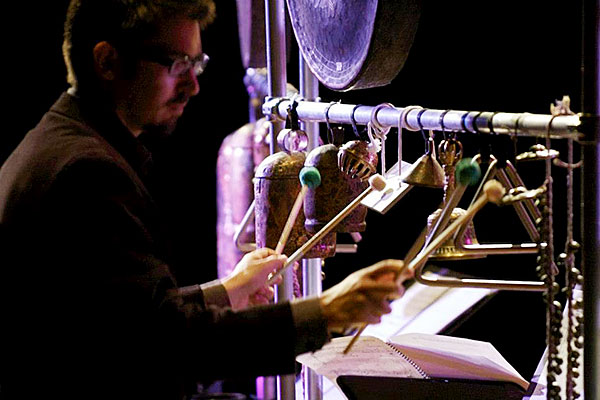
Percussion is different from other instruments. Percussionists learn to play not one instrument, but dozens, each with its own techniques. The sound quality of some percussion instruments, such as a snare drum or a cymbal, jumps out of the musical texture even when everyone else plays fortissimo. Some percussion instruments don’t produce a musical pitch.
It does have its own internal consistency, though. “Ninety-nine percent of percussion is played on either wood, drum heads, or metal,” says David Skidmore, the executive director and an ensemble member of the local group Third Coast Percussion. On Friday, TCP focuses on just one of those three materials, in a concert called Metal.
The centerpiece of the program, filling the second half of the concert, is Philippe Manoury’s Métal, for six xylophone-like instruments called sixxen. Percussion also being the most DIY of the instrument families, TCP’s members built the sixxen themselves, according to the specifications of the contemporary Greek-French composer Iannis Xenakis, who invented the instrument, and Manoury, who added a damper pedal. Each of the sixxen holds 19 metal bars cut from aluminum U-channel, arranged in a keyboard layout. Although the percussionists cut the bars to precise lengths, the six instruments are not identical because of variations in the metal, which was created with the low tolerances needed for construction, not for its sound qualities. “The resonances mix while you’re playing,” Skidmore says. “These crazy overtones and a halo of sound wafts over the concert.”
Similar uncertainty sprinkles over the other works on the program. John Cage wrote his First Construction, which appears on TCP’s 2012 all-Cage album The Works for Percussion 2, for instruments he owned, including a salvage yard-ish collection of seven anvils and four brake drums from cars. Concert-planners do their best to replicate. “The trick as a performer is knowing what the sounds of the instruments are and finding sounds that accomplish the same musical goals,” Skidmore says.
Anvil Chorus, by the contemporary composer David Lang of the New York ensemble Bang on a Can, requests resonant and nonresonant metals in the score, but leaves choices up to the performer. Skidmore will use cowbells and U-channel bars. “It’s typical Lang music,” he says. “Groove-oriented.”
James Tenney’s Koan: Having Never Written a Note for Percussion doesn’t specify the instrument it should be played on. The solo work begins as quietly as possible, then crescendos to the instrument’s loudest sound, then back to quiet over several minutes, all on the same note. The joke is that having never written a note for percussion, he then wrote just one. One note for one instrument—the exact opposite of percussion’s usual profusion. Even the different can be, well, different.
Third Coast Percussion performs Metal at International House at the University of Chicago on Friday, January 11, at 7:30 p.m. Tickets $10–$15. For more information, visit thirdcoastpercussion.com.
Graham Meyer is Chicago magazine’s contributing classical music critic.
Photograph: Tadashi Omura


